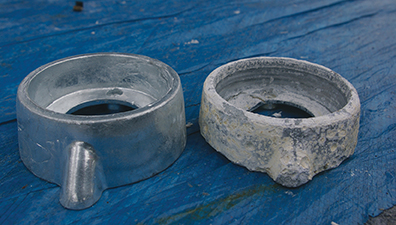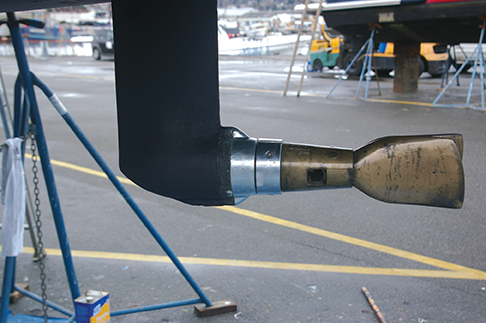Replace your anodes annually to save your boat (published April 2015)
Galvanic corrosion occurs under the water where the metal parts of your boat, and boats moored nearby, interact physically or electrically. There is metal everywhere on our boats—the stainless steel prop shaft, bronze propeller, bronze seacocks, stainless steel rudder post and the aluminum housing of sail drives. Each of these metals has its own galvanic properties with the “most noble” being the least prone to corrosion and the “least noble” being the most prone to decay.
Since you can’t eliminate all galvanic corrosion and the interaction of metals in the “electrolyte” of water—fresh, brackish and salty—sailors have known for ages that you need to create a sacrificial anode that will corrode and thereby prevent the essential metals from suffering corrosive decay.
In the circuit that exists between underwater metals, the most noble metals—shafts, props, etc—are the cathodes while the sacrificial metals that we introduce in the mix are the anodes.

While zinc has always been the chosen metal for underwater anodes, it is not the only one in use today. Zinc is still the anode of choice for boats in salt water where the electrolytic soup can induce the most damaging galvanic corrosion. But, a lot of us keep our boats in brackish and fresh water where zinc is considered more of an environmental problem. In the past few years, we have seen magnesium anodes introduced for use in fresh water and aluminum anodes created for use in brackish or salt water. Both metals are considered safer in the environment than zinc.
So, your underwater anodes and those that are integral to a sail drive or a raw water cooled inboard engine need to be replaced at least once a year. If you keep your boat in a large marina that has an old 120 volt shore power system or water that doesn’t flush with the tide daily, then you may have to replace your anodes more often.
When you remove the old anodes, make sure to clean the metal surfaces with emery paper or a Scotch Brite pad. The anode needs to be in close contact with the metals it is protecting. And you need to have enough anode surface area to counterbalance the surface areas of the cathodes you are protecting. Use Lok-Tight on the threads of the bolts that hold the anodes together or attached them to the boat so they won’t come apart in use.
Anodes are lifesavers and need to be replaced regularly. Otherwise galvanic corrosion will start to destroy the metal parts of the boat and could lead to failed seacocks, rudder posts and other vital parts that keep you afloat and sailing.

















